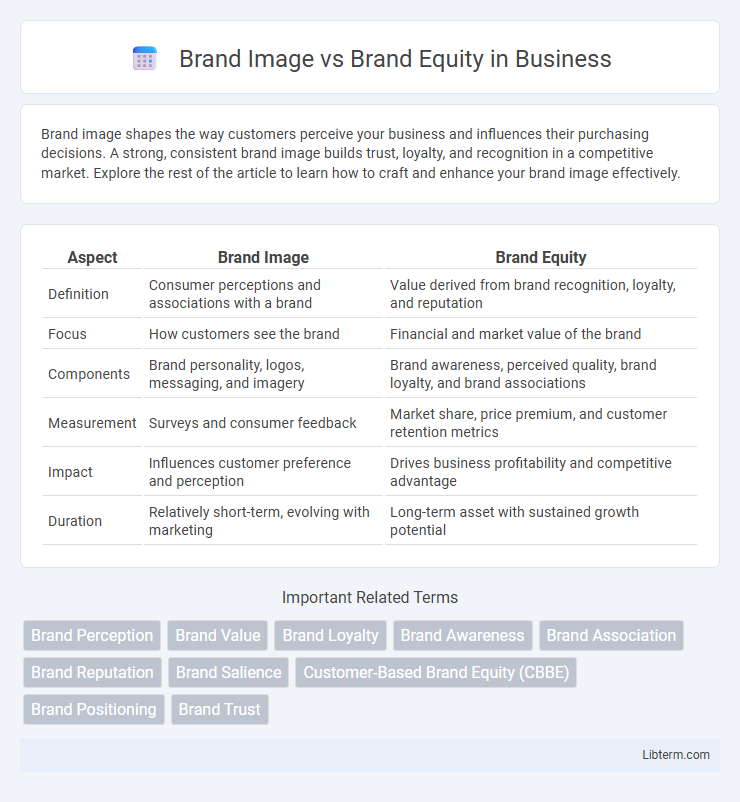Brand image shapes the way customers perceive your business and influences their purchasing decisions. A strong, consistent brand image builds trust, loyalty, and recognition in a competitive market. Explore the rest of the article to learn how to craft and enhance your brand image effectively.
Table of Comparison
| Aspect | Brand Image | Brand Equity |
|---|---|---|
| Definition | Consumer perceptions and associations with a brand | Value derived from brand recognition, loyalty, and reputation |
| Focus | How customers see the brand | Financial and market value of the brand |
| Components | Brand personality, logos, messaging, and imagery | Brand awareness, perceived quality, brand loyalty, and brand associations |
| Measurement | Surveys and consumer feedback | Market share, price premium, and customer retention metrics |
| Impact | Influences customer preference and perception | Drives business profitability and competitive advantage |
| Duration | Relatively short-term, evolving with marketing | Long-term asset with sustained growth potential |
Understanding Brand Image
Brand image represents the perceptions and associations consumers hold about a company or product, encompassing visual elements, messaging, and overall reputation. It shapes consumer attitudes and influences purchasing decisions by creating an identifiable and relatable identity in the marketplace. Effective brand image management fosters emotional connections and differentiates the brand from competitors, enhancing market presence and consumer loyalty.
Defining Brand Equity
Brand equity refers to the value a brand adds to a product or service based on consumer perceptions, experiences, and loyalty. It encompasses brand awareness, perceived quality, brand associations, and proprietary brand assets such as trademarks. This equity enhances customer preference and drives higher market share and profitability compared to non-branded competitors.
Key Differences Between Brand Image and Brand Equity
Brand image refers to the perceptions and associations consumers hold about a brand based on their experiences and interactions, while brand equity represents the overall value and strength a brand holds in the marketplace. Key differences include that brand image is a component influencing brand equity, which encompasses consumer loyalty, perceived quality, and brand awareness. Brand equity drives financial advantages and competitive positioning, whereas brand image primarily impacts consumer recognition and emotional connection.
Components of a Strong Brand Image
A strong brand image is built on components such as brand identity, which includes logo, colors, and design elements that create immediate recognition; brand personality that reflects the emotional and human traits associated with the brand; and brand associations that link positive attributes and experiences to the brand in consumers' minds. Consistent messaging, customer experiences, and perceived quality further solidify these components, reinforcing trust and loyalty. Strong brand image serves as a foundation for building brand equity, which represents the overall value and strength of the brand in the market.
Elements that Build Brand Equity
Brand equity is built through critical elements such as brand awareness, perceived quality, brand associations, and customer loyalty, which collectively enhance a brand's value and market position. Strong brand awareness ensures consumers recognize and recall the brand, while positive brand associations and perceived quality influence purchasing decisions and create emotional connections. Customer loyalty drives repeat business and advocacy, solidifying the brand's equity over time and translating into competitive advantage and financial performance.
The Role of Consumer Perception
Consumer perception plays a crucial role in shaping brand image by influencing how customers interpret brand attributes and values. This subjective interpretation directly impacts brand equity, as positive consumer perceptions enhance brand loyalty, increase perceived quality, and elevate brand associations. Consequently, managing consumer perceptions effectively strengthens brand equity by building a favorable and consistent brand image.
Measuring Brand Image and Brand Equity
Measuring brand image involves evaluating consumer perceptions through surveys, focus groups, and sentiment analysis to capture the brand's associations, attributes, and feelings in the target audience's mind. Brand equity measurement relies on financial metrics such as brand valuation, consumer loyalty indices, market share, and price premium analysis to quantify the economic value derived from brand strength. Combining qualitative brand image insights with quantitative brand equity data provides a comprehensive understanding of a brand's market position and potential growth opportunities.
Strategies to Enhance Brand Image
Strategies to enhance brand image include consistent visual identity, engaging storytelling, and delivering exceptional customer experiences that align with brand values. Leveraging social media platforms for authentic interactions and managing online reputation through timely responses to feedback further strengthens brand perception. Integrating influencer partnerships and community involvement boosts trust and emotional connection, thereby improving overall brand recognition and favorability.
Approaches to Increase Brand Equity
To increase brand equity, companies focus on enhancing brand awareness, improving perceived quality, and fostering strong brand associations through targeted marketing campaigns and consistent brand messaging. Investing in customer experience, delivering superior product quality, and engaging in corporate social responsibility initiatives contribute to building trust and emotional connections with consumers. Leveraging social media platforms and influencer partnerships further strengthens brand loyalty and drives long-term equity growth.
Brand Image and Brand Equity: Impact on Business Success
Brand image represents customers' perceptions and associations with a brand, shaping their emotional and cognitive connection, while brand equity reflects the tangible value and competitive advantage the brand holds in the marketplace. Strong brand image enhances customer trust and loyalty, which directly contributes to higher brand equity by increasing market share and enabling premium pricing. Both elements are crucial for sustaining long-term business success, as brand equity leverages positive brand image to drive profitability and market growth.
Brand Image Infographic

 libterm.com
libterm.com